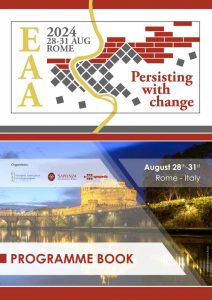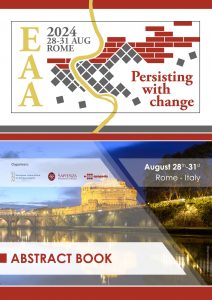Da mercoledì 28 a sabato 31 agosto 2024, la Sapienza Università di Roma ospiterà l’incontro annuale dell’European Association of Archaeologists:
Persisting with change
Il team del progetto Times of Castles organizzerà la sessione:
30 Agosto
Interdisciplinary Trajectories in Mortar Analysis of Historical Buildings
(#736)
The relationship between archaeology, history, and archaeometry is a long-debated topic that has become increasingly prominent in recent years, thanks to the constant evolution of research procedures, as well as the increasing sophistication of the tools of analysis at our disposal. As such, the creation of new frameworks of research and the continuous updating of skills and technical knowledge are essential to keep up with these developments.
To enhance current models and pave the way for new research directions, a collaborative approach is crucial. This hinges on a close dialogue between scientists and social science researchers, underpinned by a shared understanding of the procedures defining the various archaeometric specialisations.
The proposed session makes a case for this interdisciplinary approach by focusing on the processes of production of the mortars used in the construction of historical buildings. Within this field of research, the analytical archaeometric procedures adopted in recent years have become increasingly more precise in defining both the characteristics and the dating of samples. In most studies, however, the work of the scientists remains isolated from the overall data produced by historical and archaeological research.
This session draws from the experience acquired within an ongoing research project studying a series of Italian medieval castles through the archaeometric analysis of their mortars. Its objective is to initiate a dialogue with other interdisciplinary projects where mortar analysis plays a pivotal role in shaping historical models.
Taking a wide diachronic perspective, it presents a set of case studies examined through field- and lab-based procedures, comparing both different methods and their results. Ultimately, it intends to offer a valuable model of a research process that elaborates a unified and seamless interpretive framework based on different kinds of data and on the integration of different specialisations.
Il programma preliminare comprende 9 interventi:
- Giovanna Bianchi (University of Siena), Andrea Arrighetti (École normale supérieure, Université PSL), Giulia Bellato (University of Cambridge), Carmine Lubritto (University of Campania Luigi Vanvitelli), Carlo Alberto Garzonio (University of Florence), The Castles Project
- Rita Vecchiattini (Università di Genova / Istituto di Storia della Cultura Materiale-ISCUM), Giovanni Pesce (Northumbria University / Istituto di Storia della Cultura Materiale-ISCUM), Application of the Radiocarbon method to mortars in archaeological contexts
- Fabio Marzaioli (Università della Campania Luigi Vanvitelli), Isabella Passariello (Università della Campania Luigi Vanvitelli), Filippo Terrasi (Università della Campania Luigi Vanvitelli), Sara Nonni (The University of Manchester at Harwell), Michele Secco (Università di Padova), Giulia Ricci (Università di Padova), Gilberto Artioli (Università di Padova), Carmine Lubritto (Università della Campania Luigi Vanvitelli), Life after 14 years of experience with Mortar Dating by Cryo(2)SoniC procedure: Current state of the art and future perspectives
- Valeria Razzante (Università di Padova), Michele Secco (Università di Padova), Simone Dilaria (Università di Padova), Giulia Ricci (Università di Padova), Caterina Previato (Università di Padova), Jacopo Bonetto (Università di Padova), Alexandra Chavarría Arnau (Università di Padova), Gianpietro Brogiolo (Università di Padova), Fabio Marzaioli (Università della Campania Luigi Vanvitelli), Technological changes and continuities in mortar production: a valuable tool for the chronological interpretation of complex heritage contexts
- Sara Calandra (University of Florence), Emma Cantisani (National Research Council of Italy), Fabio Fratini (National Research Council of Italy), Barbara Salvadori (National Research Council of Italy), Claudia Conti (National Research Council of Italy), Andrea Arrighetti (École normale supérieure, Université PSL), Serena Barone (National Institute for Nuclear Physics / University of Florence), Lucia Liccioli (National Institute for Nuclear Physics), Mariaelena Fedi (National Institute for Nuclear Physics), Carlo Alberto Garzonio (University of Florence), Binder selection procedure of Florentine historical buildings for radiocarbon dating
- Maria Rosa Di Cicco (University of Campania Luigi Vanvitelli), Chiara Germinario (University of Sannio), Celestino Grifa (University of Sannio), Antonio Spagnuolo (Energreenup srl), Simona
Altieri (University of Campania Luigi Vanvitelli / MAReA Centre), Noemi Mantile (University of Campania Luigi Vanvitelli / MAReA Centre), Arianna Sabatella (University of Sannio), Carmine Lubritto (University of Campania Luigi Vanvitelli / MAReA Centre), Characterization and preparation of archaeological mortars for an effective radiocarbon dating: the case-study of samples from Mediterranean area - Angelo Cardone (Università di Bari Aldo Moro), Carlo Cataneo (Università del Salento), Valeria Della Penna (Università di Foggia), Giacomo Eramo (Università di Bari Aldo Moro), Pasquale Favia (Università di Foggia), Girolamo Fiorentino (Università del Salento), Roberta Giuliani (Università di Bari Aldo Moro), Matilde Stella (Università del Salento), The limekiln of the medieval settlement of Montecorvino (Foggia, Apulia): a multidisciplinary research
- Andrew V. Blackler (Hellenic Society for Near-Eastern Studies), Adamantia P. Panagopoulou (National Center for Scientific Research, Athens), Combining mortar, wood, cartographic and documentary evidence to understand the Medieval Towers of Negroponte
- Jorge Sanjurgo-Sanchez (University of A Coruña), Rebeca Blanco-Rotea (University of Minho), David M. Freire-Lista (Universidade de Trás-os-Montes e Alto Douro / Universidade de Coimbra), Rosa
Benavides García (Independent Researcher), The keys to success: interdisciplinarity in the dating of mortars from Santalla de Bóveda (Lugo, Galicia, Spain)



